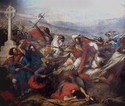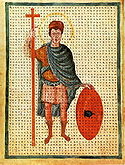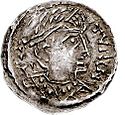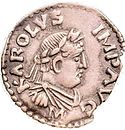- Charles, Duke of Lower Lorraine
-
 Lithograph printed in circa 1850 with the caption Founder of Brussels, circa 976
Lithograph printed in circa 1850 with the caption Founder of Brussels, circa 976
 Charles and his brother Lothair of France
Charles and his brother Lothair of France
Charles of Lorraine (Laon, 953–993 in Orléans) was the son of Louis IV of France and Gerberga of Saxony and younger brother of King Lothair. He was a sixth generation descendant of Charlemagne. Charles was excluded from the throne of France, and the German Emperor Otto II, made him Duke of Lower Lorraine in 977.
His father probably gave him royal powers in Burgundy, but Lothair took them back upon reaching his majority. In 977, he accused Lothair's wife, Emma, daughter of Lothair II of Italy, of infideility with Adalberon, Bishop of Laon. The council of Sainte-Macre at Fismes (near Reims) exonerated the queen and the bishop, but Charles maintained his claim and was driven from the kingdom, finding refuge at the court of his cousin, Otto II. Otto promised to crown Charles as soon as Lothair was out of the way and Charles paid him homage, receiving back Lower Lorraine.
In August 978, Lothair invaded Germany and captured the imperial capital of Aachen, but failed to capture either Otto or Charles. In October, Otto and Charles in turn invaded France, devastating the land around Rheims, Soissons, and Laon. In the latter city, the chief seat of the kings of France, Charles was crowned by Theodoric I, Bishop of Metz. Lothair fled to Paris and was there besieged. But a relief army of Hugh Capet's forced Otto and Charles to lift the siege on 30 November. Lothair and Capet, the tables turned once more, chased the German king and his liege back to Aachen and retook Laon.
As he had been a vassal also of Lothair, Charles' acts on behalf of Otto were considered treason and he was thereafter excluded from the throne. On Lothair's death (986), the magnates elected his son Louis V and on the latter's death (987), Hugh Capet. Thus, the House of Capet came to the throne over the disgraced and ignored Charles. Charles' marriage to the lowborn daughter of a vassal of Hugh was championed by his opponents as a cardinal reason to deny him the throne. In order to have free hand towards France, he resigned his duchy to regency of his eldest son Otto. Charles made war on Hugh, even taking Rheims and Laon. However, on Maundy Thursday[1]991 26 March, he was captured, through the perfidy of the Bishop Adalberon, and with his young second son Louis imprisoned by Hugh in Orléans, where he died a short while later, in or before 993.
In 1666, the sepulchre of Charles was discovered in the Basilica of Saint Servatius in Maastricht.[Need quotation to verify] His skin appears to have been interred there only in 1001, but that is not the date of his death, as some scholars assumed. Though Charles ruled Lower Lorraine, the Dukes of Lorraine (Upper Lotharingia) counted him as Charles I of Lorraine.
Contents
Family
Charles married firstly (970) a daughter of Robert of Vermandois, count of Meaux and Troyes. He married secondly Adelais, the daughter of low-ranking vassal of Hugh Capet. He may have married thirdly Bonne, daughter of Godfrey I, Count of Verdun.[citation needed] His children with his second and first wives were:
- Otto, succeeded him as Duke of Lower Lotharingia
- Adelaide
- Gerberga of Lower Lorraine, countess of Brussels, who married Lambert I, Count of Leuven
- Louis, followed his father to France and died in prison
- Charles (b. 989)
- Ermengarde, married Albert I, Count of Namur (various sources assign paternity of Ermengarde alternatively to Charles, or to his son Otto)
Ancestry
Ancestors of Charles, Duke of Lower Lorraine 16. Charles the Bald 8. Louis the Stammerer 17. Ermentrude of Orléans 4. Charles the Simple 18. Adalard of Paris 9. Adelaide of Paris 2. Louis IV of France 20. Alfred the Great 10. Edward the Elder 21. Ealhswith 5. Eadgifu of England 22. Æthelhelm 11. Ælfflæd 1. Charles, Duke of Lower Lorraine 24. Liudolf, Duke of Saxony 12. Otto I, Duke of Saxony 25. Oda 6. Henry the Fowler 26. Henry of Franconia 13. Hedwiga of Franconia 27. Ingeltrude of Friuli 3. Gerberga of Saxony 14. Count Dietrich of Westphalia 7. Matilda of Ringelheim 15. Reinhild Sources
- Gwatkin, H. M., Whitney, J. P. (ed) et al. The Cambridge Medieval History: Volume III. Cambridge University Press, 1926.
- Settipani, Christian. La préhistoire des Capétiens. 1993. ISBN 2-9501509-3-4
- FMG on Charles, Duke of Lower Lotharingia
Notes
Preceded by
RicharDuke of Lower Lorraine
977–993Succeeded by
OttoLegend: → ≡ "father of", · ≡ "brother of"
Begga, the daughter of Pepin I, married Ansegisel, the son of Arnulf of Metz, and was the mother of Pepin II.Pippinids Carloman → Pepin I → Grimoald I → Childebert the AdoptedArnulfings Arnulf of Metz → Clodulf · Martin · Ansegisel → Pepin II, his sons: Drogo, sons:Arnulf · Hugh · Godfrey · Pepin Grimoald I, son:Charles Martel, sons:Childebrand, son:Nibelung I → Nibelungids
Grimoald I, son:Charles Martel, sons:Childebrand, son:Nibelung I → NibelungidsEarly Carolingians Sons of Charles Martel Carloman, son:Pepin III, sons:Charlemagne, sons:Pepin the Hunchback · Charles the Younger · Pepin · Louis the Pious · Lothair · Drogo · Hugh · TheodericCarloman, son:PepinPepinBernard, sons:Carolingian Empire Sons of Charlemagne Pepin, son:Bernard → Pepin → Counts of Vermandois Louis the Pious,
Louis the Pious,
sons:Arnulf of SensLothair I, sons:Pepin I, son:Louis the German,
sons:Carloman → Arnulf → Louis the Child · Ratold · Zwentibold
Louis the Younger → Louis · Hugh
Charles the Fat → BernardCharles the Bald,
sons:Louis the Stammerer → Louis III · Carloman · Charles the Simple
Charles the Child
Carloman
Lothair the Lame · Drogo · Pepin · CharlesWest Francia West Francia was in the hands of the Robertians from 888 until 898. It was the last Carolingian kingdom. Charles the Simple, sons: Louis IV, sons:Lothair IV, sons:Louis V · ArnulfCharles of Lorraine, sons:Categories:
Louis IV, sons:Lothair IV, sons:Louis V · ArnulfCharles of Lorraine, sons:Categories:- 953 births
- 993 deaths
- People from Laon
- Dukes of Lower Lorraine
- Franks
- Frankish people
Wikimedia Foundation. 2010.

